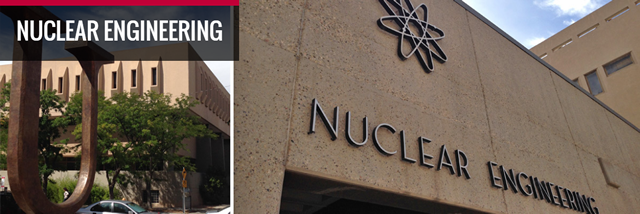
Nuclear Engineering ETDs
Publication Date
Spring 4-21-2018
Abstract
This work describes the development of radiation detection systems to identify and image special nuclear material (SNM) using low energy gamma rays. The imaging of these materials is crucial for timely, in the field responses to potential threats to national security. Using a spectroscopy system, the sources can be identified while images can be produced concurrently for the sources which are present. Two systems were designed and characterized in this study, a collimated imager which used collimation in front of a small CdTe detector, and a pixelated pinhole imager, using a pinhole mask in front of a pixelated CZT detector. Low energy gamma rays are notoriously hard to detect and image, so differing collimation or masking schemes as well as varying imaging techniques were applied to each system. The systems were modeled using geometric and mathematical approximations, then simulated using Monte Carlo methods before finally being implemented in laboratory experiments. Varying the collimator or pinhole mask materials as well as the distance and type of radiation source, over energy ranges applicable to that of SNM, provided experimental setups that could mimic field interdiction work.
The results for both systems were images with a spatial resolution of better than 1 cm as well as energy spectra that could be used to identify the radiation source present. The collimated imager is able to detect material up to one meter distant while in a self- contained, portable enclosure. For the pinhole mask in front of the pixelated detector, using a single pinhole optimized for the pixelated detector geometry gave a high- resolution image, though poor geometric efficiency. Using the multiple pinhole mask rather than a single pinhole created several sub-images per detection run which can then be used to synthesize detailed reconstructions of the original source, with increased resolution over that of the individual sub-images. The single and multiple mask pinhole designs were compared. The multiple pinhole design had two benefits over the single pinhole, this design greatly increased the geometric efficiency and thus the total intensity on the detector, and the information contained in the full array of sub-images was also used to extract depth of field information about the radiation sources.
Keywords
Radiation detection, spatial imaging, pixelated detector, multiple pinhole imaging
Document Type
Thesis
Language
English
Degree Name
Nuclear Engineering
Level of Degree
Masters
Department Name
Nuclear Engineering
First Committee Member (Chair)
Adam Hecht
Second Committee Member
Cassiano de Oliveira
Third Committee Member
Paul DeRego
Recommended Citation
Baldez, Phoenix. "Design and Characterization of Systems for Direct Spatial Imaging of Low-Energy Gamma-Radiation Sources." (2018). https://digitalrepository.unm.edu/ne_etds/68


